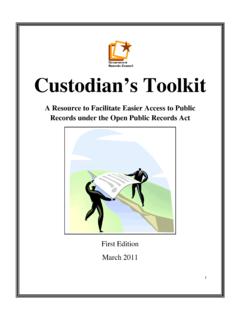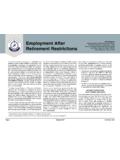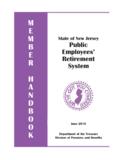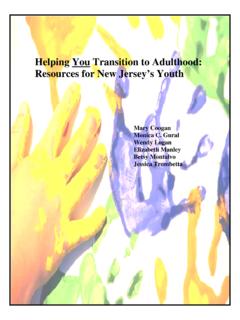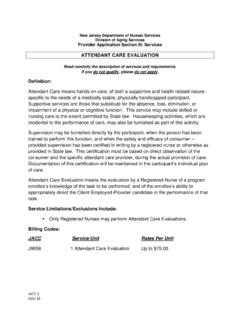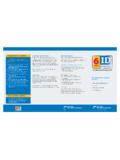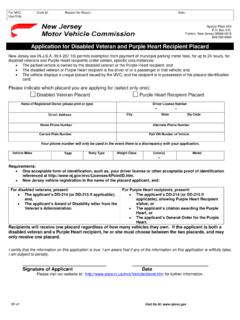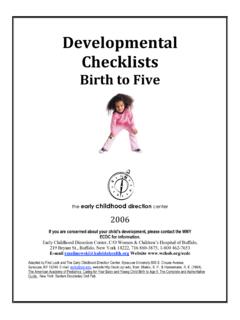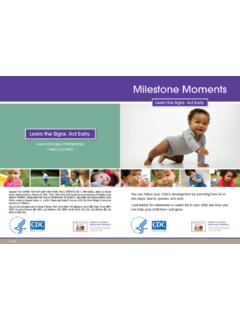Transcription of Early Learning Standards
1 2013 New Jersey Birth to ThreeNew Jersey Council for Young ChildrenAdopted/Adapted with permission from Early Childhood Indicators of Progress: Minnesota s Early Learning Guidelinesfor Birth to ThreeEarly Learning StandardsEarly Learning StandardsTABLEOFCONTENTSB ackground and and and I: Social and Emotional : Trust and Emotional with Peers and II: Approaches to : III: Language Development and : Listening and and IV: Cognitive : Exploration and and Symbolic V: Physical and Motor : Gross Motor Motor Health and of and New Jersey Council for Young Children was established in January 2010 to ensurecollaboration and coordination among Early childhood programs in the State of New Birth-to-Eight Early Learning and Development Standards Committee of the Councilhas responsibility for the development of a coherent set of Early Learning and developmentand program Standards that address all areas of development for ages birth through eightthat will lead to positive outcomes for infants, young children and their its first task, the Committee began the process of developing Birth to Three Early LearningStandards by conducting extensive research of state Early Learning guidelines/ Standards .
2 Anumber of states infant and toddler Early Learning guidelines/ Standards were reviewed andevaluated using a rubric designed to assess how well each met essential research-based criteriaidentified by the Committee. As a result of this process, the Committee, with the approval ofthe Council, requested permission to adopt/adapt theEarly Childhood Indicators of Progress:the Minnesota s Early Learning Guidelines for Birth to ThreeasNew Jersey s Birth-to-ThreeEarly Learning Standards . We gratefully acknowledge the Minnesota Department ofHuman Services for granting us permission to use, adopt and adapt their strategic Committee entered into a partnership with the national ZERO TO THREE organization for technical assistance to support the work of the Committee.
3 TheCommittee also identified a consultant to facilitate the revision of theEarly ChildhoodIndicators of Progress: the Minnesota s Early Learning Guidelines for Birth to Three. Roberts, who served as a consultant and author for Minnesota Early LearningGuidelines, was engaged as a consultant to work with the field review of a draft version of theNewJerseyBirthtoThreeEarlyLearningSta ndardswas coordinated by Dr. Keri Giordano and conducted during May through August involvement, feedback and contributions of many individuals and groups throughoutthe state are gratefully following members of the Committee have given generously of their time, knowledgeand experience for the success of this JerseyBirth to Three Early Learning StandardsBackgroundandAcknowledgements23 Laura C.
4 Morana Chairperson,Red Bank Borough Schools, NJ Council for YoungChildren;ArleneMartin Co-Chairperson,Professional Impact New Jersey and KeanUniversity;DianaAutin,Statewide Parent Advocacy Network;AmandaBlagman,Advocatesfor Children of New Jersey (ACNJ);ElaineBogoloffandCathyJoseph,NJ Department ofChildren and Families, Office of Licensing;TerriBuccarelli,Coalition of Infant/ToddlerEducators;NezzieDeFrank,Pr ofessional Impact New Jersey;LindaGillespie,ZERO TOTHREE Organization;Keri Giordano, Early Childhood Specialist;Michelle Keenan,Beachwood Nursery School;BarbaraKiley,Coalition of Infant/Toddler Educators and NJCouncil for Young Children;SonjadeGrootKim,Kean University;ShondaLaurel,NJDepartment of Human Services/DFD, NJ Council for Young Children;LisaLockwood,NewJersey Association for the Education of Young Children and NJ Council for Young Children;BeverlyLynn,Programs for Parents, Inc.
5 And NJ First Steps Northern Region;PeterMangione,National Expert Reviewer;Karen Melzer,NJ Department of Health, EarlyIntervention System;Pat Mennuti,Community Coordinated Child Care;KathleenMulrooney,ZERO TO THREE Organization;Barbara Pittman,Family Child CareProvider;KathleenPriestley, Advocates for Children of New Jersey;AliceRose,McGuireAir Force and NJ Council for Young Children;VeronicaRay,NJ Head Start Association andNJ Council for Young Children;StacySalley-Proctor,Programs for Parents, Inc. and NJ FirstSteps Northern Region;JenniferSantana, Early Head Start and Coalition of Infant/ToddlerEducators;MegSaunders,Lake wood Economic Action Program;CatherineScott-Little,National Expert Reviewer;DianneStetson,ZERO TO THREE Organization;LorriSullivan,Youth Consultation Services Institute for Infants and Preschool Mental Health;ElmoriaThomas,Southern Regional Child Care Resource Center/EIRC and NJ First Steps Southern Region;LynnTroianelli,Community Coordinated Child Care and NJ First Steps- Central Region;Joann Vesay,Rider University;Robin Wilkins,NJ Department ofEducation, Division of Early Childhood and NJ Council for Young Children, Project Director.
6 SuzanneWilliamson,Coalition of Infant/Toddler Educators and Monday Morning, JerseyBirth to Three Early Learning StandardsEarly Learning andDevelopment Standards CommitteeThe years from birth to three are the most important years of a child s development as it is theperiod of greatest change and growth in life. Development during these Early years occurswithin the context of caring and nurturing relationships. These years also provide the foundationfor the behaviors, skills and competencies that support lifelong Learning and and toddler Learning and development are nurtured and supported in a variety of settings,including: children s homes; family, friend and neighbor homes; family child care homes; child care, Early Head Start and Head Start centers.
7 And Early intervention Jersey Birth to Three Early Learning Standardsprovide families, child care providers, Early childhood teachers, institutions of higher Learning , community members and policymakers with research-based information to support the best Learning and development forinfants and Jersey Birth to Three Early Learning Standardsprovide a commonframework for understanding and communicating developmentallyappropriate expectations for infants and toddlers. These standardsare based on research about what children should know(understand) and do (competencies and skills) in differentdomains of Learning and document was developed with three goals in mind:1. To provide information which families and othercaregivers can use to better understand develop-mentally appropriate expectations for infants andtoddlers and support Learning and development inthose To promote healthy child growth and development,high quality child care and Early childhood educationfor all children birth to three, including infants andtoddlers with special needs and those Learning a homelanguage other than To provide a common framework for those who are providing services tobenefit families with infants and following Guiding Principles informed the development of theNewJersey Birth to Three Early Learning Standards :1.
8 Infantsandtoddlersdevelopinthecontextoft heirfamilies, child is unique with his/her own temperamentand rate of development. Development is influenced by many differentfactors, including physical and emotional health and well being, nutrition,sensitive and responsive caregiving and the quality of their enriches family life and is a significant contributor to the waysdevelopment is supported in families and Nurturing and responsive caregiving helps infants and and toddlers withsecure and trusting relationships with adults and peers are better able tolearn, play and grow. Infants and toddlers are active learners who learnthrough play, interaction with others and active exploration of Theyearsfrombirthtothreerepresentaperiod ofrapidgrowthanddevelopmentandare critical for the healthy development of young beginsprenatally and Learning during the first three years provides the foundation for schoolreadiness and success in school and life.
9 Positive Early experiences can help reducedevelopmental delays and foster optimal growth and Multipleabilitiesandskillsaredevelopings imultaneouslyinachild sfirstthreeyearsof , example, growth in an infant s ability to remember affects how he/she responds to newpeople. Any single behavior we observe may involve multiple aspects of of the whole child requires maximizingpotential across all Individual children varyconsiderably in achievingdevelopmental age alone is nota good measure of a child sdevelopment because themanyinfluencesondevelopment result in a wideage range of normal or typical who do have specialneeds can be identified andreferred to Early interventionservices to increase and enhancetheir ability to achieve thesedevelopmental Jersey Birth to Three Early Learning Standardsare intended asa framework for supporting the growth and development of very youngchildren in the age period of birth to three years.
10 The indicators,examples and strategies are based on widely held developmentalexpectations observed in infants and toddlers at different ageswithin the infancy to three-year period. This period is separatedinto four age groups that make the Standards more user-friendlyand correspond to shifts or transitions in development. Younginfants between the ages of birth to 9 months are in a stage ofvery rapid development that includes the integration of sensory,motor, social/emotional, language and cognitive systems. Babiesat this age need the emotional security that comes from closerelationships with primary caregivers. Older infants are infantsbetween the ages of 8 months to 18 months whose increased abilityto explore and move greatly affects their interactions with their social andphysical environments.
